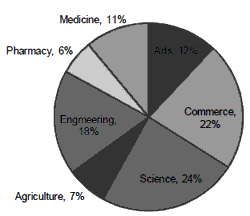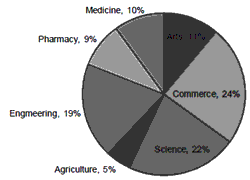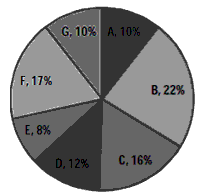Directions: Study the following pie-diagrams carefully to answer these questions:
Number of students studying in different faculties in the years 2001 and 2002 from
State X
Year-2001
Total Students - 35000
Year-2001
Total Students - 35000

Year - 2002
Total Students - 40000
Total Students - 40000

1. In which faculty there was decrease in the number of students from 2001 to 2002?(a) None
(b) Arts
(c) Agriculture
(d) Pharmacy
(b) Arts
(c) Agriculture
(d) Pharmacy
2. What is the ratio between the number of students studying pharmacy in the years 2001 and 2002 respectively?(a) 4 : 3
(b) 3 : 2
(c) 2 : 3
(d) 7 : 12
(b) 3 : 2
(c) 2 : 3
(d) 7 : 12
3. What was the approximate percentage increase in the number of students of Engineering from the year 2001 to 2002?(a) 17
(b) 15
(c) 25
(d) 20
(b) 15
(c) 25
(d) 20
4. In the year 2001, the number of students studying Arts and Commerce together is what percent of the number of students studying these subjects together in 2002?(a) 76
(b) 85
(c) 82
(d) 79
(b) 85
(c) 82
(d) 79
5. In which of the following faculties the percent increase in the number of students was minimum from 2001 to 2002?(a) Arts
(b) Science
(c) Commerce
(d) Medicine
(b) Science
(c) Commerce
(d) Medicine
Directions: Study the following graph carefully and answer the questions given below it.
Distribution of candidates enrolled for MBA and the candidates who have successfully completed the course from different institutes
Candidates Enrolled = 2500

Candidates who have successfully completed the course = 1900

6. Which institute has the highest percentage of students successful to enrolled?(a) D
(b) E
(c) A
(d) B
(b) E
(c) A
(d) B
7. What percent of candidates from institute D have come out to to be successful out of the total candidates enrolled from this institute?(a) 115
(b) 95
(c) 80
(d) 85
(b) 95
(c) 80
(d) 85
8. What is the approximate percentage of students successful to enrolled from institute A?(a) 92
(b) 89
(c) 86
(d) 96
(b) 89
(c) 86
(d) 96
9. What is ratio of candidates successful to enrolled from the institutes B and C together?(a) 55 : 12
(b) 5 : 7
(c) 135 : 271
(d) 3 : 5
(b) 5 : 7
(c) 135 : 271
(d) 3 : 5
10. What is the percentage of students successful from institutes E and F together, over the students enrolled fromthese institutes together?(a) 76
(b) 105
(c) 80
(d) 74
(b) 105
(c) 80
(d) 74
